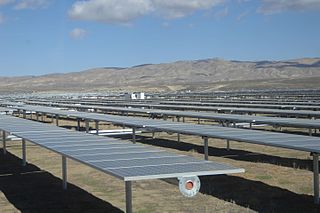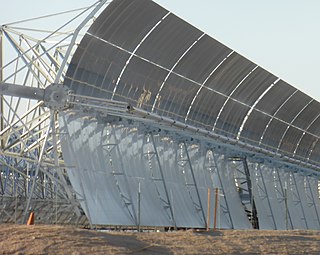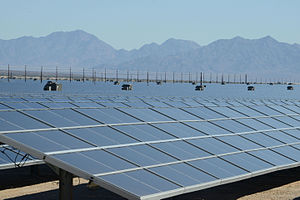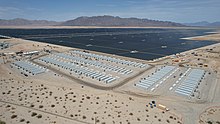
Solar Energy Generating Systems (SEGS) is a concentrated solar power plant in California, United States. With the combined capacity from three separate locations at 354 megawatt (MW), it was for thirty years the world's largest solar thermal energy generating facility, until the commissioning of the even larger Ivanpah facility in 2014. It was also for thirty years the world's largest solar generating facility of any type of technology, until the commissioning of the photovoltaic Topaz Solar Farm in 2014. It consisted of nine solar power plants in California's Mojave Desert, where insolation is among the best available in the United States.

There are several solar power plants in the Mojave Desert which supply power to the electricity grid. Insolation in the Mojave Desert is among the best available in the United States, and some significant population centers are located in the area. These plants can generally be built in a few years because solar plants are built almost entirely with modular, readily available materials. Solar Energy Generating Systems (SEGS) is the name given to nine solar power plants in the Mojave Desert which were built in the 1980s, the first commercial solar plant. These plants have a combined capacity of 354 megawatts (MW) which made them the largest solar power installation in the world, until Ivanpah Solar Power Facility was finished in 2014.

According to data from the US Energy Information Administration, renewable energy accounted for 8.4% of total primary energy production and 21% of total utility-scale electricity generation in the United States in 2022.

Solar power includes solar farms as well as local distributed generation, mostly on rooftops and increasingly from community solar arrays. In 2023, utility-scale solar power generated 164.5 terawatt-hours (TWh), or 3.9% of electricity in the United States. Total solar generation that year, including estimated small-scale photovoltaic generation, was 238 TWh.

Topaz Solar Farms is a 550 megawatt (MWAC) photovoltaic power station in San Luis Obispo County, California, United States. Construction on the project began in November 2011 and ended in November 2014. It is one of the world's largest solar farms. The $2.5 billion project includes 9 million CdTe photovoltaic modules based on thin-film technology, manufactured by U.S. company First Solar. The company also built, operates and maintains the project for MidAmerican Renewables, a Berkshire Hathaway company. Pacific Gas and Electric will buy the electricity under a 25-year power purchase agreement. According to First Solar, it created about 400 construction jobs.

The California Valley Solar Ranch (CVSR) is a 250 megawatt (MWAC) photovoltaic power plant in the Carrizo Plain, northeast of California Valley. The project is owned by NRG Energy, and SunPower is the EPC contractor and technology provider. The project constructed on 1,966 acres (796 ha) of a 4,365-acre (1,766 ha) site of former grazing land. It is utilizing high-efficiency, crystalline PV panels designed and manufactured by SunPower. The project includes up to 88,000 SunPower solar tracking devices to hold PV panels that track the sun across the sky.

Solar power has been growing rapidly in the U.S. state of California because of high insolation, community support, declining solar costs, and a renewable portfolio standard which requires that 60% of California's electricity come from renewable resources by 2030, with 100% by 2045. Much of this is expected to come from solar power via photovoltaic facilities or concentrated solar power facilities.

The Ivanpah Solar Electric Generating System is a concentrated solar thermal plant in the Mojave Desert. It is located at the base of Clark Mountain in California, across the state line from Primm, Nevada. The plant has a gross capacity of 392 megawatts (MW). It uses 173,500 heliostats, each with two mirrors focusing solar energy on boilers located on three 459 feet (140 m) tall solar power towers. The first unit of the system was connected to the electrical grid in September 2013 for an initial synchronisation test. The facility formally opened on February 13, 2014. In 2014, it was the world's largest solar thermal power station.

The Blythe Mesa Solar Power Project, also known as the Blythe Solar Energy Center, is a 235 megawatt (MWAC) photovoltaic power plant near the city of Blythe in Riverside County, California. It occupies about 2,000 acres of public land managed by the Bureau of Land Management in the Mojave Desert. The construction uses CdTe thin film panels from the U.S. firm First Solar, and the majority of the output is being sold to Kaiser Permanente and Southern California Edison under 20-year power purchase agreements.

The Copper Mountain Solar Facility is a 802 megawatt (MWAC) solar photovoltaic power plant in Boulder City, Nevada, United States. The plant was developed by Sempra Generation. When the first unit of the facility entered service on December 1, 2010, it was the largest photovoltaic plant in the U.S. at 58 MW. With the opening of Copper Mountain V in March 2021, it again became the largest in the United States. It is co-located with the 64 MW Nevada Solar One, 150 MW Boulder Solar, and 300 MW Techren Solar projects in the Eldorado Valley, thus forming a more than 1 gigawatt (GW) solar generating complex. By comparison, generating capacity at the nearby Hoover Dam is about 2 GW.

The Mojave Solar Project (MSP) is a concentrated solar power (CSP) facility in the Mojave Desert in California, about 20 miles (32 km) northwest of Barstow. Surrounding the hamlet of Lockhart, Mojave Solar is adjacent to Harper Lake and the SEGS VIII–IX solar plant.
The Avenal Solar Facility is a 57.7 megawatt (MW) photovoltaic power station in Kings County, California, constructed using 450,900 SHARP-128W thin-film modules. At its completion, it was California's largest photovoltaic facility.
The following outline is provided as an overview of and topical guide to solar energy:
The Antelope Valley Solar Ranch 1 (AVSR1) is a 230 megawatt (MWAC) photovoltaic power plant near Lancaster within Antelope Valley, in the western Mojave Desert, Southern California. It uses cadmium telluride modules made by the US thin-film manufacturer First Solar. The project was developed by First Solar and later bought by Exelon Corporation in 2011. The solar facility was fully commissioned in April 2014.
The McCoy Solar Energy Project is a 250 megawatt (MWAC) photovoltaic power plant near the city of Blythe in Riverside County, California. It occupies about 2,300 acres of mostly public land in the Mojave Desert. The construction uses CdTe thin film panels from First Solar, and the output is being sold to Southern California Edison under a power purchase agreement.

The Genesis Solar Energy Project is a concentrated solar power station located in the Mojave Desert on 1,920 acres (780 ha) of Bureau of Land Management land, in eastern Riverside County, California. The plant is owned/managed by Genesis Solar, LLC, a subsidiary of NextEra Energy Resources, LLC. The Genesis Solar Energy Project is located about 25 miles (40 km) west of Blythe, in the Lower Colorado River Valley. The plant was built in the Colorado Desert along an ancient trade route that native people had traveled for thousands of years. The route traversed the Sonoran Desert and enabled trade between the Colorado River and the coast.
Solar Star is a 579-megawatt (MWAC) photovoltaic power station near Rosamond, California, United States, that is operated and maintained by SunPower Services. When completed in June 2015, it was the world's largest solar farm in terms of installed capacity, using 1.7 million solar panels, made by SunPower and spread over 13 square kilometers.
The Springbok Solar Farm is a 443 MWp (350 MWAC) photovoltaic power station in the northwestern Mojave Desert, near California City in eastern Kern County, California. The facility was developed and constructed by 8minutenergy Renewables in three phases. It is among the country's largest PV solar farms with a capacity of about 440 MWp (350 MWAC).
The Beacon Solar Project is a photovoltaic power station in the northwestern Mojave Desert, near California City in eastern Kern County, California. Split into five phases, the combined Beacon solar facilities generate 250 MW of renewable energy for the Los Angeles Department of Water and Power (LADWP). The five phases of the project, fully completed in December 2017, include a total of 903,434 individual solar photovoltaic modules, mounted onto Nextracker single-axis tracking systems.













